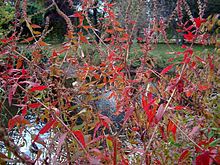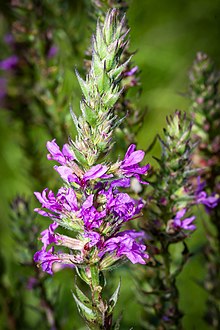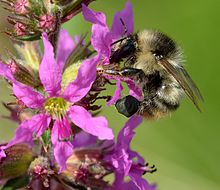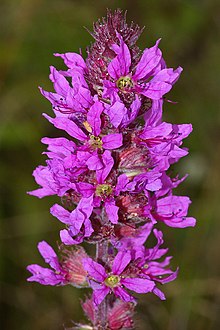| Lythrum salicaria | |
|---|---|

| |
| Conservation status | |
 Least Concern (IUCN 3.1) | |
| Scientific classification | |
| Kingdom: | Plantae |
| Clade: | Tracheophytes |
| Clade: | Angiosperms |
| Clade: | Eudicots |
| Clade: | Rosids |
| Order: | Myrtales |
| Family: | Lythraceae |
| Genus: | Lythrum |
| Species: | L. salicaria |
| Binomial name | |
| Lythrum salicaria L. | |
Lythrum salicaria or purple loosestrife is a flowering plant belonging to the family Lythraceae. It should not be confused with other plants sharing the name loosestrife that are members of the family Primulaceae. Other names include spiked loosestrife and purple Lythrum. This herbaceous perennial is native to Europe and Asia, and possibly Australia.
Etymology and other names
The generic name Lythrum is derived from the Greek 'lythron', meaning blood, in reference to the flower colour in some species. However, Pliny (A.D. 23–79) stated that Lythrum is named for Lysimachus, an army general and friend of Alexander the Great. Lysimachus is derived from the Greek lysis, meaning "loosing" and mache, meaning "strife".
The specific epithet salicaria derives from the similarity of the leaves to those of willows or Salix species.
The English word loosestrife first appeared in written form in the 16th century. It was coined by English naturalist William Turner in his 1548 work A New Herball, in which he states: " may in englishe be called red loosestryfe or purple loosestryfe."
Purple loosestrife was referred to several times as 'long purples' by John Clare, such as in his 1821 poem The Wildflower Nosegay:
"Where on the water op'd the lily buds
And fine long purples shadow'd in the lake..."
— Volume II of The Village Minstrel and Other Poems, John Clare, pg. 133
Description
Lythrum salicaria can grow 1–2 m (3 ft 3 in – 6 ft 7 in) tall, forming clonal colonies 1.5 m (4 ft 11 in) or more in width, with numerous erect stems growing from a single woody root mass. The stems are reddish-purple and square in cross-section. The leaves are lanceolate, 3–10 centimetres (1–4 in) long and 5–15 millimetres (3⁄16–9⁄16 in) broad, downy and sessile, and arranged opposite or in whorls of three.
The flowers are reddish purple, 10–20 millimetres (1⁄2–3⁄4 in) in diameter, with six petals (occasionally five) and 12 stamens, and are clustered tightly in the axils of bracts or leaves, (a type of inflorescence called a verticilaster), there are three different flower types, with the stamens and style of different lengths, short, medium or long; each flower type can only be pollinated by one of the other types, not the same type, thus ensuring cross-pollination between different plants. For instance, if the pistil is medium length, then the stamens will be long and short, but not medium. The flowers are visited by many types of insects, and can be characterized by a generalized pollination syndrome.
The fruit is a small 3–4 millimetres (1⁄8–5⁄32 in) capsule containing numerous minute seeds. Flowering lasts throughout the summer. When the seeds are mature, the leaves often turn bright red through dehydration in early autumn; the red colour may last for almost two weeks. The dead stalks from previous growing seasons are brown.

L. salicaria is very variable in leaf shape and degree of hairiness, and a number of subspecies and varieties have been described, but it is now generally regarded as monotypic with none of these variants being considered of botanical significance. The species Lythrum intermedium Ledeb. ex Colla is also now considered synonymous.
Distribution

Lythrum salicaria is native to Europe, temperate Asia and northwest Africa. It is also naturalized in many temperate parts of the world, including parts of southern Africa, North America, and South America. The species was thought to be a recent introduction to Australia, but pre-colonial pollen samples have been found in New South Wales, indicating another route of introduction; the question is considered unresolved by Australian authorities.
Ecology
Found in ditches, wet meadows and marshes and along sides of lakes. In North America, purple loosestrife can invade sedge meadows.
Associated insects

The flowers are pollinated by long-tongued insects, including bees and butterflies.
A number of insects use Lythrum salicaria as a food resource.
The black-margined loosestrife beetle Galerucella calmariensis is a brown beetle with a black line on its thorax. The adult feeds on the leaves of the plant, producing characteristic round holes. Its larvae destroy tender leaf buds and strip the tissue from the leaves. The golden loosestrife beetle Galerucella pusilla is nearly identical to G. calmariensis, but usually lacks the black thoracic line. Its feeding habits are also quite similar to the other leaf beetle.
The loosestrife root weevil Hylobius transversovittatus is a large red nocturnal weevil, which spends its nights feeding on leaves and leaf buds. The larvae emerge from their eggs and immediately burrow into the root of the plant, which they feed on continuously for over a year. This root damage stunts the plant's growth and ability to create seeds. If several larvae inhabit the same root, the plant can be killed.
The loosestrife flower weevil Nanophyes marmoratus is a tiny weevil which lays a single egg in each flower. When the larvae emerge they eat the flowers' ovaries, and the plant is unable to create seeds. The larvae usually proceed to hollow out the flower buds and use them as safe places to pupate.
Caterpillars of the engrailed moth (Ectropis crepuscularia), a polyphagous geometer moth, also feed on purple loosestrife.
Cultivation, uses and impact
It has been used as an astringent medicinal herb to treat diarrhea and dysentery; it is considered safe to use for all ages, including babies. It is also cultivated as an ornamental plant in gardens, and is particularly associated with damp, poorly drained locations such as marshes, bogs and watersides. However, it will tolerate drier conditions. The flowers are showy and bright, and a number of cultivars have been selected for variation in flower colour, including:
- 'Atropurpureum' with dark purple flowers
- 'Brightness' with deep pink flowers
- 'Happy' with red flowers on a short (60 cm or 24 in) stem
- 'Purple Spires' with purple flowers on a tall stem
- 'Roseum Superbum' with large pink flowers.
The cultivars ‘Blush’ with blush-pink flowers, and 'Feuerkerze' with rose-red flowers have gained the Royal Horticultural Society's Award of Garden Merit.
It has also been introduced in many areas of North America by bee keepers, due to its abundance of flowers which provide an important source of nectar.

As an invasive species

Purple loosestrife has been introduced into temperate New Zealand and North America where it is now widely naturalised (spreading on its own) and officially listed in some controlling agents. Infestations may rarely result in dramatic disruption in water flow in rivers and canals, and the life cycles of organisms from waterfowl to amphibians to algae being affected.
A single plant may produce up to 2.7 million tiny seeds annually. Easily carried by wind and water, the seeds germinate in moist soils after overwintering. The plant can also sprout anew from pieces of root left in the soil or water. Once established, loosestrife stands are difficult and costly to remove by mechanical and chemical means.
Plants marketed under the name "European wand loosestrife" (L. virgatum) are the same species despite the different name. In some cases the plants sold are sterile, which is preferable.
In North America, purple loosestrife may be distinguished from similar native plants (e.g., fireweed Chamerion angustifolium, blue vervain Verbena hastata, Liatris Liatris spp., and spiraea (Spiraea douglasii) by its angular stalks which are square in outline, as well as by its leaves, which are in pairs that alternate at right angle and are not serrated.
Biological control
Purple loosestrife provides a model of successful biological pest control. Research began in 1985 and today the plant is managed well with a number of insects that feed on it. Five species of beetle use purple loosestrife as their natural food source, and they can do significant damage to the plant. The beetles used as biological control agents include two species of leaf beetle: Galerucella calmariensis and Galerucella pusilla; and three species of weevil: Hylobius transversovittatus, Nanophyes breves, and Nanophyes marmoratus. Infestations of either of the Galerucella species is extremely effective in wiping out a stand of purple loosestrife, defoliating up to 100% of the plants in an area. The moth Ectropis crepuscularia is polyphagous and a pest species itself, and unsuitable for biological control.
References
- Kavak, S. (2014). "Lythrum salicaria". IUCN Red List of Threatened Species. 2014: e.T164323A42329075. doi:10.2305/IUCN.UK.2014-1.RLTS.T164323A42329075.en. Retrieved 13 July 2023.
- ^ Flora of NW Europe: Lythrum salicaria Archived 2008-02-19 at the Wayback Machine
- "Lythrum salicaria - Plant Finder". www.missouribotanicalgarden.org. Retrieved 2021-11-01.
- ^ Stajsic, Val (27 March 2018). "Lythrum salicaria L. Purple Loosestrife". VicFlora. Royal Botanic Gardens Victoria. Retrieved 27 October 2022.
- Gledhill D. 1985. The Names of Plants. Cambridge University Press ISBN 978-0-5213-6675-5
- ^ Mitich LW. 1999. Lythrum salicaria L. Weed Technology 13: 843 – 846.
- Grigson G. 1974. A Dictionary of English Plant Names. Allen Lane. ISBN 978-0713904420.
- ^ "Lythrum salicaria". Flora of China vol. 13. 2007. p. 282. Retrieved 27 October 2022.
- ^ Blamey, M. & Grey-Wilson, C. (1989). The Illustrated Flora of Britain and Northern Europe. Hodder & Stoughton. ISBN 0-340-40170-2.
- Meeuse Ph.D., B.J.D. (1961). The Story of Pollination. New York: Ronald Press Co. p. 174- 175 with illust.
- Van Der Kooi, C. J.; Pen, I.; Staal, M.; Stavenga, D. G.; Elzenga, J. T. M. (2015). "Competition for pollinators and intra-communal spectral dissimilarity of flowers". Plant Biology. 18 (1): 56–62. doi:10.1111/plb.12328. PMID 25754608.
- Clapham, A.R., Tutin, T.G. and Warburg, R.F. 1968. Excursion Flora of the British Isles. Cambridge University Press. ISBN 0 521 04656 4
- ^ "Lithium salicaria". Flora Europaea. Royal Botanic Garden Edinburgh. Retrieved 27 October 2022.
- "Lythrum salicaria". Germplasm Resources Information Network. Agricultural Research Service, United States Department of Agriculture.
- Med-Checklist:
- "Lythrum salicaria". Australian Plant Name Index (APNI). Centre for Plant Biodiversity Research, Australian Government. Retrieved 15 March 2023.
- Romanowski, Nick (2011). Wetland Weeds: Causes, Cures and Compromises. Collingwood, Victoria: CSIRO Publishing. p. 34. ISBN 978-0643103955.
- Webb, D.A., Parnell, J. and Doogue, D. 1996. An Irish Flora. Dundalk, Ireland: Dundalgan Press (W.Tempest) Ltd. ISBN 0-85221-131-7.
- "Sedge Meadow". Fermilab. Fermi National Accelerator Laboratory. Retrieved 29 October 2022.
- Plants for a Future: Lythrum salicaria
- Huxley, A., ed. (1992). New RHS Dictionary of Gardening. Macmillan ISBN 0-333-47494-5.
- "RHS Plantfinder - Lythrum salicaria 'Blush'". Retrieved 25 March 2018.
- "RHS Plant Selector - Lythrum salicaria 'Feuerkerze'". Retrieved 27 December 2020.
- "AGM Plants - Ornamental" (PDF). Royal Horticultural Society. July 2017. p. 62. Retrieved 25 March 2018.
- Shatkovskaya, T.; Epifanova, T.; Romanenko, N.; Bulgakov, V. (2020). "Innovative approach to legal regulation for using beekeeping data in forest areas". IOP Conference Series: Earth and Environmental Science. 595 (1). IOP Publishing: 012005. doi:10.1088/1755-1315/595/1/012005. ISSN 1755-1307. S2CID 229411171. Skvortsova, T.; Epifanova, T.; Pasikova, T.; Shatveryan, N. (2021). "Regulation of beekeeping as a vector of green economy's institutional development". IOP Conference Series: Earth and Environmental Science. 937 (3). IOP Publishing: 032120. doi:10.1088/1755-1315/937/3/032120. ISSN 1755-1307. S2CID 245383136. These reviews cite this research. Benvenuti, Stefano; Benelli, Giovanni; Desneux, Nicolas; Canale, Angelo (2016). "Long lasting summer flowerings of Lythrum salicaria as honeybee-friendly flower spots in Mediterranean basin agricultural wetlands". Aquatic Botany. 131. Elsevier BV: 1–6. doi:10.1016/j.aquabot.2016.02.002. ISSN 0304-3770. S2CID 87290197.
- Anderson, Mark G. (1995-03-01). "Interactions betweenLythrum salicaria and native organisms: A critical review". Environmental Management. 19 (2): 225–231. doi:10.1007/BF02471992. ISSN 1432-1009.
- "Non-native Invasive Freshwater Plants - Purple Loosestrife (Lythrum salicaria)". Archived from the original on 7 July 2016. Retrieved 6 June 2014.
- Wilson, Linda M.; Schwarzlaender, Mark; Blossey, Bernd; Randall, Carol Bell (2004). "Biology and Biological Control of Purple Loosestrife" (PDF). Morgantown, WV: USDA Forest Health Technology Enterprise Team. Retrieved 27 October 2022.
External links
- Invading Species.com Ontario Ministry of Natural Resources and Ontario Federation of Anglers and Hunters
- Species Profile - Purple Loosestrife (Lythrum salicaria), National Invasive Species Information Center, United States National Agricultural Library. Lists general information and resources for Purple Loosestrife.
| Taxon identifiers | |
|---|---|
| Lythrum salicaria |
|